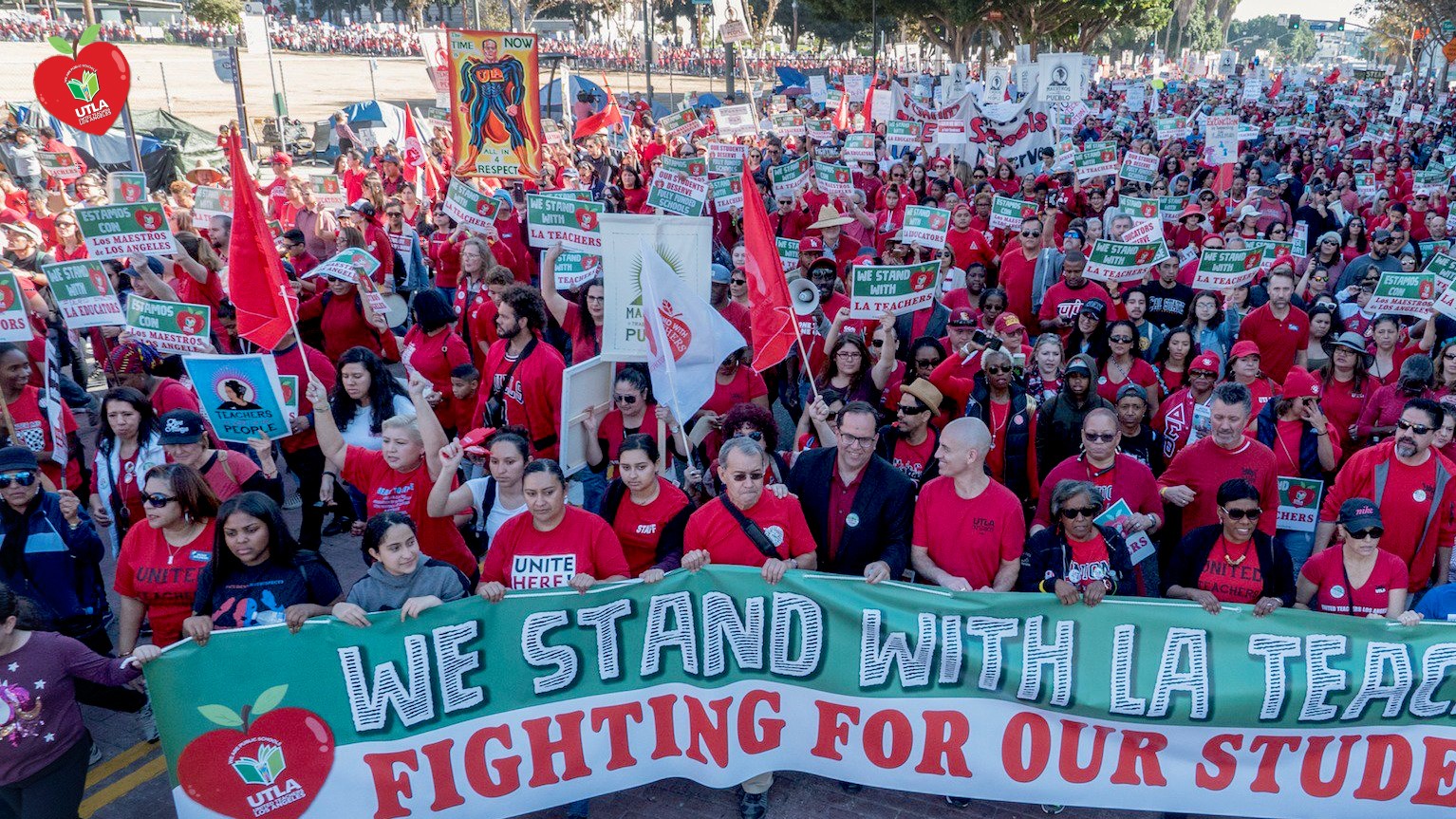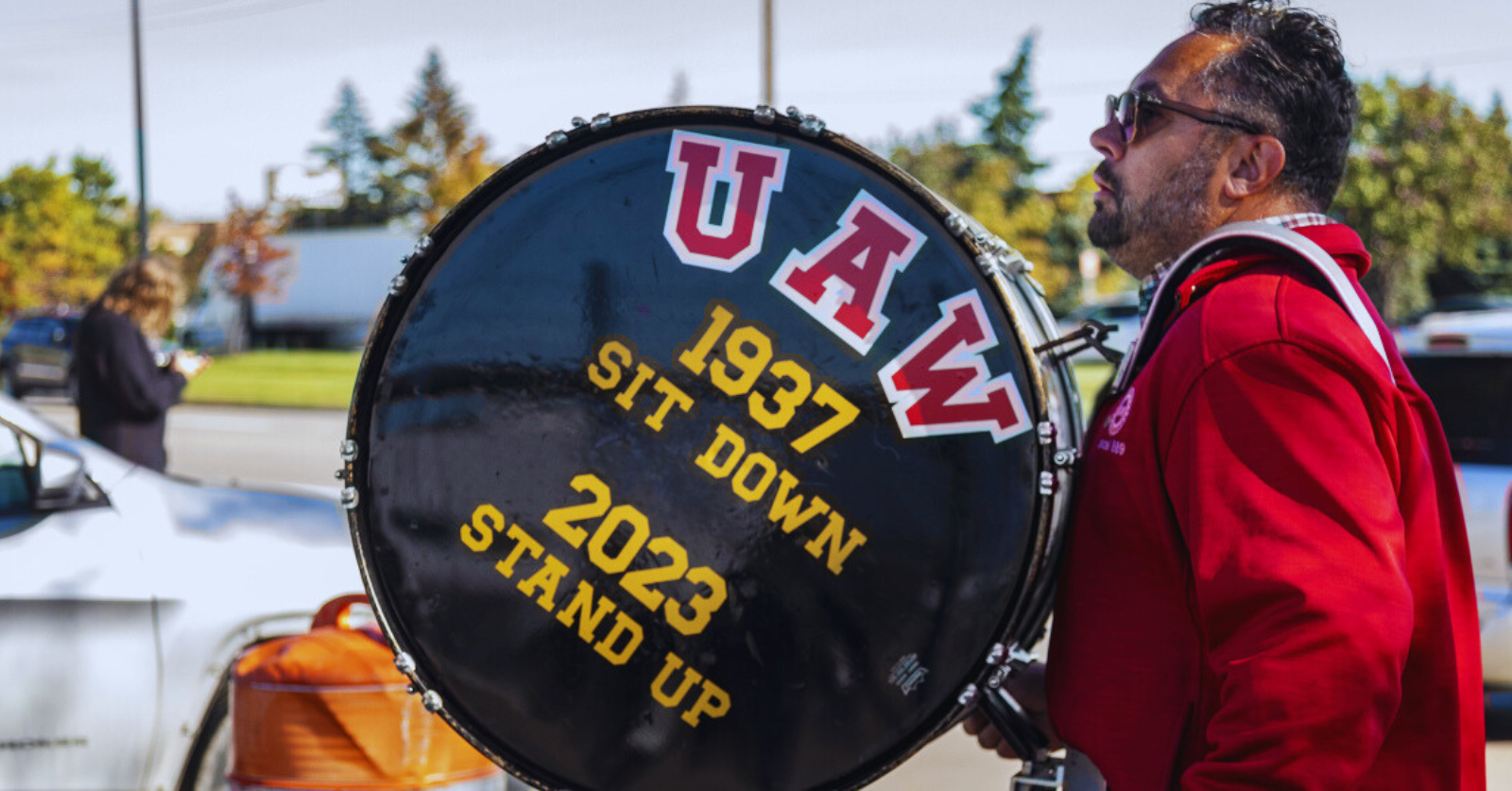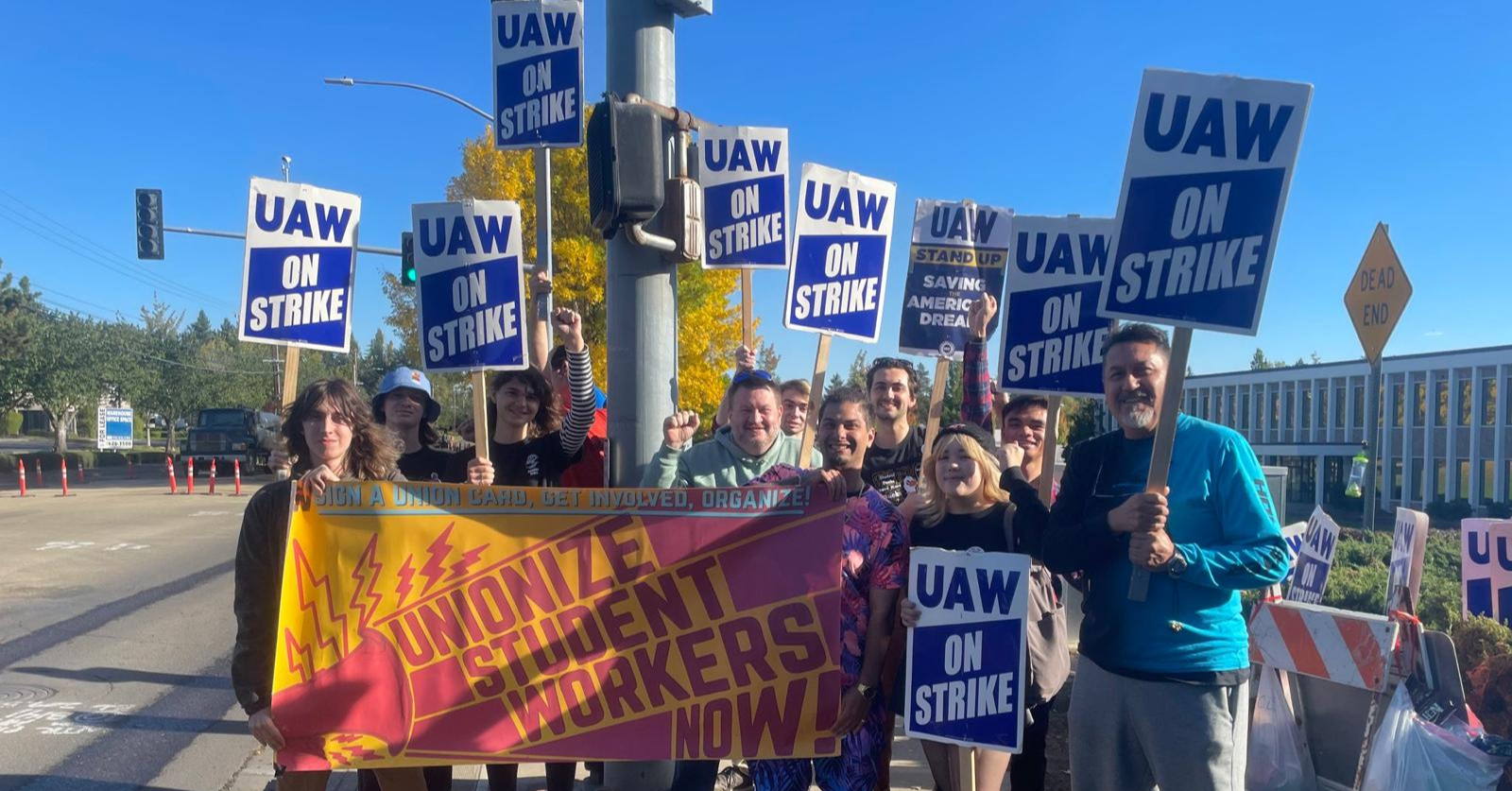If you like this piece, read more about where we stand and sign up to get our occasional email bulletins!
Lately, I’ve been thinking a lot about something I heard in a series of 1964 talks from Farrell Dobbs. Dobbs was a leader in the Socialist Workers Party who came out of the legendary 1934 Minneapolis General Strike led by rank-and-file Teamsters and socialists. Along with city-stopping mass strikes that year in San Francisco and Toledo, the Minneapolis Teamsters strike marked a turning point in the Great Depression: In 1934 the defeats and demoralization for workers of the previous decade were supplanted by victory after victory.
These incredible uprisings — Dobbs describes the Minneapolis strikes as “virtual civil war” — proved to millions that if they organized together and fought back against capitalist control over their lives, they could not only win better wages and conditions but dignity and a new sense of autonomy and solidarity. Over the next 10 years, millions of workers would go on strike, organize into unions, and win major concessions from bosses and the government.
By 1964, worker militancy had subsided (though, by today’s standards, 1964 would still be an incredible year of strikes). Through the 1950s and 1960s, the Red Scare and repression of the Left resulted in mass purges of radicals and the “militant minority” from the labor movement. Partly because of this purge, the official leadership of the U.S. labor movement became increasingly undemocratic, politically conservative, and oriented towards collaborating with management rather than challenging it. Among other things, this meant that some major labor leaders, as Dobbs points out, even shunned the Civil Rights Movement (though others were strong supporters).
By the 1960s, many leftists were pessimistic that the American working class still had the revolutionary potential it might have had in other places or times. But Dobbs kept the faith. Speaking to an audience of young socialists who had not lived through earlier periods of intensified class struggle, Dobbs told a parable about the mayfly. The mayfly lives its whole life, beginning to end, in three hours. Dobbs asks the young activists to imagine that one of these flies is born at one in the morning and, before it dies a few hours later, a newborn mayfly asks the now elder fly what the human race is like. The elder responds: “The bastards sleep all the time.”
For those who have not personally experienced a period of intense class struggle — like everyone in my generation, myself included — it is easy to believe that working people are “asleep” and won’t resist the exploitation and injustices of capitalism. But, for Dobbs, our history, especially that of the 1930s and 1940s, proves that the working class can wage incredible class struggles on a massive scale. Dobbs went on to speak of the strike wave immediately following World War II, which saw more workers than ever before shutting down production and in the streets, concluding that this was a “demonstration of the capacity of the working class to assert itself, to be ingenious about it, to be inventive, to be creative, to be bold. And that also is the whole history of the working class.” Dobbs saw firsthand how this power can transform lives and rearrange society in a more just way.
In 2018, we got a glimpse of what this power and ingenuity can do, starting this February in West Virginia. Fed up with tax cuts for corporations and the wealthy paid for with cuts to the public employee health insurance program, overcrowded classrooms, crumbling school facilities, brutal teacher turnover rates, and nearly the lowest pay in the country, West Virginia school workers — led in part by socialist teachers — went on the offensive. They shut down the state and in the process won historic concessions.
But beyond concessions from the state, what the teachers won was confidence — not just for themselves but for the whole American working class. As West Virginia teacher and strike leader Jay O’Neal said in an interview that day: “If we can do it, anybody can do it. It’s not like we’re a special group of activist teachers who have been studying for 20 years about how to mobilize the working class. We’re not.”
Almost immediately, tens of thousands of teachers in states from Arizona to Oklahoma to North Carolina started mobilizing for their own mass strikes, frequently in defiance of state laws and Republican state governments backed by Trump and Betsy DeVos. This fall, teachers in Louisiana killed a government giveaway to Exxon with the threat of a political strike and Chicago teachers led the nation’s first charter-school strike.
Austerity and privatization have nearly dismantled public education in many U.S. cities while securing windfalls for billionaires and relieving corporations of paying for experienced teachers and quality schools. For the first time in my life, thanks to these brave teachers, it now seems possible to reverse the trend of increasing inequality and ever tighter corporate control over society — and to do so through the force that Marx and Engels argued over 150 years ago would change the world for the benefit of all humanity: an organized working class fighting consciously in its own interests.
Now the teachers strike wave is rising here in California.
In 2014, a rank-and-file reform caucus took leadership of the Los Angeles teachers union, United Teachers Los Angeles (UTLA). UTLA represents nearly 35,000 teachers in schools serving over half a million students — more than twice the size of West Virginia’s entire public school population. Since then, these teachers have been organizing hard against a billionaire-backed plan to cut taxes, slash school budgets, privatize all the city’s schools, and break the teachers union altogether.
That organizing is now paying off. In August, 81 percent of UTLA members turned out to vote on whether or not to authorize a strike if the Los Angeles school district doesn’t capitulate. Of those who voted, 98 percent of UTLA members voted in favor of the strike authorization. Ninety percent of LAUSD students are not white, and 85 percent are low-income, so teachers’ demands — including competitive wages to retain experienced teachers, smaller class sizes, more support staff like nurses, reduced standardized testing, and stricter regulation on charter schools — are not just for themselves but for the diverse working class of LA. UTLA leadership has stressed that every one of its demands is a racial justice demand.
Now signs reading “We Stand With LA Teachers” and “Estamos Con Los Maestros de Los Angeles” can be seen in store and restaurant windows across Los Angeles. Meanwhile UTLA blasts speeches, music videos, and even a nightly news update on social media, encouraging teachers and parents to get involved while denouncing the privatizer-led school board. (Underscoring the ingenuity and vitality of this nascent working-class movement, rank-and-file Virginia music teachers also just released their own excellent music video, “Won’t Fund Me,” to the tune of Cee Lo Green’s “Fuck You.”)
On December 15, a diverse crowd of 50,000 people marched in downtown Los Angeles in support of the teachers. Videos of the march showed a sea of red reminiscent of the massive state capitol demonstrations in West Virginia, Arizona, and Oklahoma at the height of the strikes in those states last year. And just last month, UTLA leaders announced that the teachers will be going on strike starting January 10.
In a press conference announcing the strike date, UTLA President Alex Caputo-Pearl made clear that the war on public education is a war on the whole working class and that teachers are ready and willing to lead the fight back. “If we strike,” he said, “it will be a strike for our students … a strike for educational justice, and a strike for racial justice… We have watched underfunding and the actions of privatizers undermine our students and our schools for too long. No more… Our students and families are worth the investment and we must achieve the schools LA students deserve.”
While LA teachers have been leading what might be the most impressive mass, class-struggle mobilization I’ve seen in my life, earlier in 2018 a rank-and-file reform slate of Oakland teachers took leadership in their own union, Oakland Education Association (OEA). Now, OEA is taking a cue from teachers in West Virginia and LA, mobilizing their membership towards a potential shutdown in 2019. And last month, about 100 teachers from three Oakland schools, unsatisfied with the pace of bargaining and frustrated with the insulting offers from management, took matters into their own hands and held a one-day, wildcat strike.
I met the teachers’ demonstration at city hall and was moved by what I saw. In one moment reminiscent of the sense of rage and power we saw on the steps of the West Virginia legislature in 2018, Oakland teachers and students confronted a school district representative sent to do PR damage control. A high school math teacher explained that for his 35 students, the district only provides 28 desks. A special-education teacher, complaining of stagnant wages and skyrocketing rents, told the story of a coworker who resorted to living in a trailer and asking the PTA if any parents have a driveway she can park it in. But the crowd was far from demoralized. They chanted, “Chop from the top!” and repeatedly declared their readiness to strike. Months before an official, union-sanctioned strike, Oakland teachers are already mobilizing, aware of their own capacity as workers to disrupt business as usual.
In his short biography of Lenin, Lars Lih tells the story of one of Lenin’s comrades, Boris Gorev, who “remembered coming home one day during the great Petersburg strikes of 1895–6 and finding two of his women friends … twirling around the apartment in sheer delight.” They were celebrating because their faith in the potentially transformative but as yet unrealized power of the Russian working class was finally vindicated by the mass strikes. For years, activists like Gorev and his collaborators had watched as their comrades in Germany succeeded in building a powerful mass socialist workers’ movement. But many Russian activists were skeptical that such a thing was possible in the economically backward and politically repressive Tsarist Russian empire. At last, the strikes confirmed that the Russian working class was no different than their brothers and sisters in Germany — working people everywhere hate oppression and exploitation, and when they move, the world shakes.
Lih writes that Lenin remembered the story as a confirmation of a “heroic scenario” in which an organized, conscious, and “heroic” working class discovers its own, transformative power to change the world. Lenin even insisted on reminding people of how weak and divided the socialist and workers movements were at that time.
“[T]his weakness was actually a source of encouragement. If such a feeble organization helped to generate an unprecedented strike movement, what could not be accomplished by a properly organized [socialist workers’ movement]? … Faced with such intoxicating perspectives, no wonder Lenin’s activist friends danced across the kitchen floor.”
Just as Lenin and his comrades doubled down on organizing a working-class movement on the basis of these preliminary victories, today’s socialists are recognizing the incredible potential in an organized and self-confident working class evidenced by the teacher mobilizations across the country. As Los Angeles and Oakland teachers ramp up for a battle in 2019, DSA members from the Bay to LA are proud to stand by their side in building popular support for their fight. Meanwhile, across the country, socialists are helping to rebuild labor’s “militant minority,” taking rank-and-file union jobs and fighting for a militant, democratic, and socially progressive labor movement.
The teacher strike wave will only grow more formidable this spring: in the last few weeks alone we heard about teachers boiling over in frustration in South Carolina, Indiana, and Virginia. Meanwhile the Democratic Socialists of America is approaching 60,000 members, a likely Bernie Sanders presidential campaign is set to activate tens of millions of people around the politics of class struggle and multiracial solidarity, and demands for Medicare for All and a Green New Deal have rapidly become mainstream, receiving majority support even among Republican voters. The working class is starting to flex its muscles at the same time that a reborn socialist current is raising the expectations of millions of ordinary people.
In the grand arc of history, we’re all mayflies of class struggle, living through only a short window of activity. Most of my life, the working class has been unable to rise from the nightmare of neoliberalism. But as we watch workers en masse discovering their own power, we should remember that the high levels of class struggle that are now beginning to seem possible are far from exceptions in U.S. history. These first stirrings of a new working-class movement could be just the start of something far greater.




